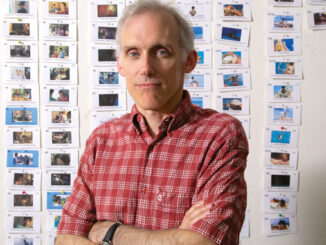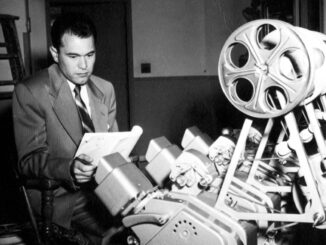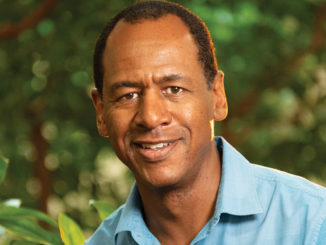
by Edward Landler • portraits by Martin Cohen
Picture editors’ storytelling skills are tested in animation to a degree rarely demanded in any other kind of film. In live-action, they may come on to a project to consult and prepare before production begins, but their work usually begins when the cameras start rolling and footage comes into the cutting room.
Unlike real-life situations, where one could look for a science fiction book illustrator for hire or a comic book artist to depict the imagery and get the visualization to life, in animation, the editor starts serving the story only after the project is approved. Even before storyboarding, he or she sets up the editorial department to serve as a central hub for all the production elements, including storyboards, layouts, animation, music, dialogue, sound effects, and more. From pre-production on, with a script often constantly in flux, the show is reworked continuously and the editorial keeps track of the constant evolution of picture and sound.
Animation makes the editor a collaborator with virtually every department on the project. But, unlike any other fictional narrative motion picture, it brings the editor into close collaboration with the writer. To explore this unique relationship, CineMontage contrasts the development of this collaboration in two very different animated shows: Disney’s hit feature Frozen (2013), inspired by Hans Christian Andersen’s tale The Snow Queen, and Warner Bros.’ TV series airing on the Cartoon Network, The Looney Tunes Show (2011-13), with the classic Warner ‘toon characters inhabiting contemporary suburbia.
THE LOONEY TUNES SHOW
Originally conceived as a sketch comedy, The Looney Tunes Show developed into a 22-minute animated situation comedy with Bugs Bunny and Daffy Duck sharing a house in the suburbs. Also featuring a broad range of Warner favorites, including Porky Pig, Elmer Fudd and Yosemite Sam, the updated setting offered great opportunities for satiric comedy that would appeal to adults as well as kids.
Supervising producers Spike Brandt and Tony Cervone realized that for the specific timing needed for the comedy to work, the show required younger writers with backgrounds in performance. As writers, they brought in Hugh Davidson and Rachel Ramras, and later Larry Dorf, all alumni of the Groundlings improvisation group.
The producers also knew they would need far more collaboration than usual among the key departments to perfect the show. “The process for making feature animation and television animation is very much the same, except in TV you have to work faster with fewer people to do it,” says Cervone, noting also that most of the show’s production team had feature experience. “The script is still the king of the show.”
Working faster to meet scheduled episode air dates meant having only two weeks for final scripts to develop from idea to table reading to recording session – with star voices Jeff Bergman and Bob Bergen and frequent guest voices such as Kristen Wiig, Fred Armisen and June Foray. The sound master track coming out of the session was like a radio play from which the storyboards were drawn. Unlike feature animation, there was very little room for script changes after this.
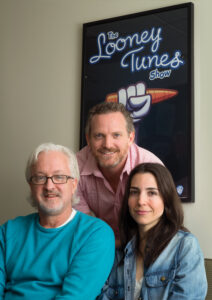
“The sound master track is the timeline track,” says veteran animation editor Craig Paulsen, who cut the show through its entire production run. “Craig supplied the consistency, the backbone of the show; he was central to developing the routine that made it work for three years,” says producer Cervone.
As the storyboards and the layouts blocking out the composition and movement came back into editorial, the animatics stage of the process took over. During this time, the sequence directors made sure the story played as close to the script as possible. The rough animatics were done within four to six weeks, but then they had to be re-cut, re-timed and re-fixed many times over before they were precise enough to go to animation. Meanwhile the sound editors – ADR, dialogue and effects – did the corresponding work on the soundtrack.
Paulsen worked with the directors at this stage. The writers also had a pass on the material and, early in the run of the show, the editor started to work more closely with them to capture the suburban comic satire. Paulsen points out, “It was a big deal to make sure that the tone was correct. These subtleties have to be built into the animatics.”
Writers Davidson and Ramras immediately recognized the editor’s writing skills. “We were so naïve. Craig was the first to put timing in to make it a comedy. He showed us how to solve storytelling problems without doing more animation,” says Davidson. Ramras agrees, adding, “It was like walking into an empty apartment. Craig found the places to put in the stuff to make it funny by doing things with sound and timing.”
The writers started working with Paulsen during the animatics stage of the fourth and fifth Looney Tunes Show scripts. That helped establish their collaborative routine and things subsequently went more smoothly for the whole show. By the end of the first year, Davidson and Ramras’ input at the recording sessions had also become essential and now, at the animatics stage, they were able to alert the editor for things to watch for when the animation came back.
With showrunners Brandt and Cervone keeping the train on the track, the drawings and animatics were sent off to animation. They came back to editorial anywhere from four to six months later. During that time, at least eight more scripts had been written and gone into animatics. At any single time, the Looney Tunes team was working on five or six different episodes.
With the raw animation back in editorial, that particular show would enter its “A-frame” stage, and Paulsen would turn his attention to it for final re-cutting, re-timing and re-fixing. Most of this he did himself with only a few things needing to be sent back to animation. For the entire production, Paulsen edited on a Mac using Final Cut Pro and Adobe Photoshop.
When Davidson and Ramras came in for their pass on the “A-frame” stage, they found Paulsen with his script out. They were always scheduled for a four-to-six-hour session with the editor. That amount of time was necessary during the early run of the show, but by late in the first season, they were done by lunch. “Very rarely did we have to change things in the ‘A-frame’ stage,” says Davidson. Ramras notes, “We should have brought popcorn.”
FROZEN
One way to point up the difference between a big- budget animated feature production and an episodic animated TV show would be to note that the time it took for Frozen to go from studio green light to release bracketed the entire production run of The Looney Tunes Show. Another difference for Frozen from most other animated projects, TV and feature, was that the writers – Chris Buck and Jennifer Lee (who joined the team later) – were also the directors. Editor Jeff Draheim and Buck, however, started collaborating on the project even before Disney gave it the go-ahead.
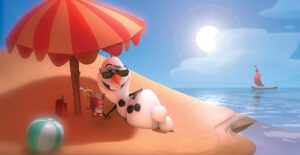
Walt Disney Studios Motion Pictures
Late in 2009, Buck pitched his Snow Queen concept to the studio. He had contributed notes to The Princess and the Frog, which Draheim had just wrapped, and he asked the editor to create a reel to help sell the project to Disney Animation heads Ed Catmull and John Lasseter. Cutting together clips from other movies for internal studio use, it evoked the emotional tone of the proposed film.
Knowing this could be his job for three-and-a-half years, Draheim had to be sure he was comfortable with his closest collaborators. “We must have a friendly relationship and both love the project,” Draheim explains. This was clearly the case with this project. “Jeff ‘s been a partner the whole way through,” says Buck.
After the first script was approved early in 2010, the storyboard artists came on board under head of story Paul Briggs. Consulting with Buck, the board artists worked out the shot-by-shot development of each sequence. Meanwhile, both editor and writer/director oversaw the recording sessions for the scratch tracks with temp voices for the characters.
Once completed, any given storyboard sequence first went to Draheim, editing on Avid Film Composer. After picking the dialogue takes, he would put board drawings, dialogue and temp music together, setting their timing and rhythm, and create story reels. “I like to have the first pass at cutting a sequence to help develop the trust,” he says. “The first version is what I think the board artists intended, but I’m going to want to change things.”
Using Adobe Photoshop and After Effects, Draheim enhanced the story reel as well as making alternative versions for Buck – and for both Buck and Lee, later on. “Usually, Jeff does the story artists’ version and then he has his own version. Then he gives a lot of choices,” says Buck.
Draheim recalls, “When Chris and Jenn come in, they say, ‘Play the one you like first.'” For the editor, his main concern in collaborating with the writer/directors was to “get inside their heads and know what they want. I try to keep two steps ahead of them.”
An important part of the Disney Animation production process is a screening every three to four months for the “brains trust,” the studio’s top executives and key creative personnel. This is to show how each project looks at that point in its evolution and to identify problems recognized in common. “It has to look and feel like a real motion picture,” notes Draheim.
For the first seven or eight Frozen screenings, Draheim constructed the movie from storyboard drawings and scratch music, dialogue and sound effects tracks. He created a feature-length version of the film for each screening. Buck says, “He had to put the whole thing together again every three months. Meanwhile, things had to keep moving ahead: re-boarding, character development, layouts to prepare for animation. I don’t know when he ate and slept.”
Early in 2012, after two years in storyboards, the production went through a major change. The studio pushed up the release date for the film from late 2014 to late 2013. Such an aggressive schedule could have caused breakdowns in communication at every level in every department. Throughout the entire production, however, Draheim notes, producer Peter Del Vecho “helped set the tone and the mood with his professional, calm demeanor. Losing a year forced us to have a stronger sense of collaboration.”
Around the same time, Lee, co-writer of Disney’s Wreck-It Ralph (2012), began to work along with Buck as writer/director. “She had already been coming in to give notes on the story and I loved what she wrote,” Buck observes. “She already had the same vision for the film as I did. John and Ed saw what a good team we made and, of course, there was no way without Jeff.”
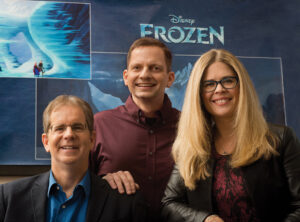
From this point on, Buck, with extensive experience in animation, gravitated toward watching over layout and animation while Lee’s writing background led her toward storyboarding and editorial. Buck and Draheim’s regular daily meetings in the Disney Animation basement now included Lee. “We always came back together in editorial at least once a day, usually more,” explains Draheim.
The ongoing goal was to get all sequences approved for animation as quickly as possible. Layout Supervisor Scott Beattie’s team came in and worked with Draheim on the storyboard shots to prepare the layouts. These went back to the writer/directors before being sent on to the Animation Department, headed by Lino DiSalvo. Sequences for two of the songs written by Robert Lopez and Kristin Anderson-Lopez were approved early on, including the “Let It Go” scene. “Animation and Effects were able to spend a lot of time on that sequence to help make it the show-stopper that it is,” Draheim notes.
As 2013 began, after three years of listening to temp sound effects and music, sound designer Odin Benitez, composer Christophe Beck and music editors Earl Ghaffari and Fernand Bos sped up their efforts to finalize the sound. With no final score and about half the film shown in storyboards, Frozen had its first audience preview in April.
Feedback from the preview was overwhelmingly positive and the entire production crew rode its momentum to completion. As the fully animated sequences came back to editorial, Draheim, Buck and Lee spent even more time together to oversee the final cutting and timing for release.
“We were still re-doing entire sequences in the last two months, and tweaking and refining dialogue to the last moment,” adds Draheim, who won this year’s ACE Eddie Award for Best Edited Animated Feature Film for Frozen.
Despite the clear differences between the accelerated production of multiple animated episodes for a TV series and the continual reworking and refining of the painstakingly elaborate elements comprising the production of a single animated feature, the basic process and key components are the same. Similarly, the contrasting collaborations between editor and writers on The Looney Tunes Show and Frozen demonstrate their shared passion for telling stories through animation. In both, the editor exercised his storytelling skills and attention to detail to help realize the writers’ vision.



